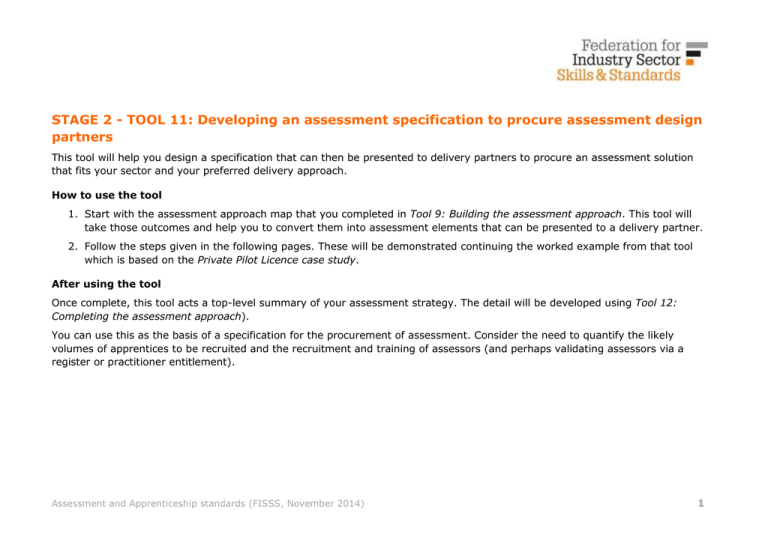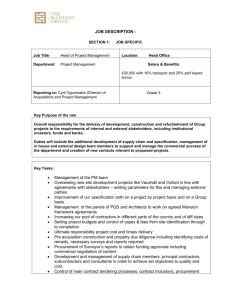STAGE 2 - TOOL 11: Developing an assessment specification to
advertisement

STAGE 2 - TOOL 11: Developing an assessment specification to procure assessment design partners This tool will help you design a specification that can then be presented to delivery partners to procure an assessment solution that fits your sector and your preferred delivery approach. How to use the tool 1. Start with the assessment approach map that you completed in Tool 9: Building the assessment approach. This tool will take those outcomes and help you to convert them into assessment elements that can be presented to a delivery partner. 2. Follow the steps given in the following pages. These will be demonstrated continuing the worked example from that tool which is based on the Private Pilot Licence case study. After using the tool Once complete, this tool acts a top-level summary of your assessment strategy. The detail will be developed using Tool 12: Completing the assessment approach). You can use this as the basis of a specification for the procurement of assessment. Consider the need to quantify the likely volumes of apprentices to be recruited and the recruitment and training of assessors (and perhaps validating assessors via a register or practitioner entitlement). Assessment and Apprenticeship standards (FISSS, November 2014) 1 Step 1: Look at your assessment strategy output (output from Tool 9) Competency Statement Competency Type Refined Competency Type Priority Assessment Method Match End Test Companion Aircraft Structure Knowledge Factual Knowledge Essential High Written Assignment Written Examination Airworthiness Knowledge Regulatory Knowledge Essential High Written Assignment Audio/Video Evidence Human Performance Behaviours Role Specific Behaviours Practical Observation Interview Meteorology Knowledge Factual Knowledge Essential High Written Assignment Written Examination Navigation VFR Knowledge Regulatory Knowledge Essential High Written Assignment Audio/Video Evidence Navigation Planning Skills Developing Skill High Practical Observation Audio/Video Evidence Radio and Comms Skills Repetitive Skill High Practical Observation Observed Assessment Aircraft Ops Skills Repetitive Skill High Practical Observation Observed Assessment Principles of Flight Knowledge Factual Knowledge Desirable Medium Observed Assessment Written Assignment Air Law Knowledge Factual Knowledge Essential High Written Assignment Written Examination Flight Log Skills Mandatory or Regulatory High Practical Observation Audio/Video Evidence Medium Look for common themes and the most important assessment methods. In the worked example above: The knowledge components are mostly assessed using written assignments. These will need to be identified, developed, tested and trialled as part of your procurement. The skills elements are all practical observation. How this is undertaken (with all the development of consistent recording tools) will need careful planning and clear signposting in a procurement strategy. Assessment and Apprenticeship standards (FISSS, November 2014) 2 Step 2: Map the assessment methods for your assessment approach For each of the competency types (skills, knowledge and behaviour), record the following using the template provided overleaf: Percentage of assessment resource: Estimate the percentage of the total assessment resource allocated to each component (each row should total 100%) This will help to plan the main components and ensure that the assessment delivery partner assigns development resource accordingly. Number of assessments: Estimate the number of different assessment resources to be developed. For example in the worked example shown below, there is only one practical observation assessment, but it is repeated 45 times in a programme, so the assessment recording tool should only be developed once, but be repeatable and useful as competence develops (with a saving on development costs). This also helps in preparing the resources (see later). Synoptic end-test %: Using the output from previous tools, estimate the total coverage of the end-test. This will help to define the structure and weighting of the end test. The range across all three rows should add up to 100%. For the worked example, it is clear that the knowledge tests and practical skills elements are the central focus for resource development. The map for the worked example might look like this: Percentage of assessment resource Project Professional Multiple Dialogue Choice Synoptic Practical Assessment Observation Observed Expert Assessment Panel Interview Written /Viva Assignment Audio/Video Evidence Evidence Portfolio Knowledge 5 0 25 20 0 25 10 0 10 0 5 Skills 0 0 0 25 75 0 0 0 0 0 0 Behaviours 0 0 5 10 60 0 15 0 0 0 10 Number of Assessments Project Professional Multiple Dialogue Choice Synoptic Practical Assessment Observation Observed Expert Assessment Panel Interview Written /Viva Assignment Audio/Video Evidence Evidence Portfolio Knowledge 1 0 9 1 1 1 1 0 4 0 1 Skills 1 0 0 0 1 1 1 0 0 0 1 Behaviours 1 0 2 1 1 1 1 0 0 0 1 Synoptic endtest % Project Professional Multiple Dialogue Choice Synoptic Practical Assessment Observation Observed Expert Assessment Panel Interview Written /Viva Assignment Audio/Video Evidence Evidence Portfolio Knowledge 2 0 30 15 5 0 5 0 0 0 0 Skills 0 0 0 15 10 5 0 0 0 0 0 Behaviours 0 0 2 5 5 0 1 0 0 0 0 Assessment and Apprenticeship standards (FISSS, November 2014) 3 Mapping template Percentage of assessment resource Project Professional Multiple Dialogue Choice Synoptic Practical Assessment Observation Observed Expert Assessment Panel Interview Written /Viva Assignment Audio/Video Evidence Evidence Portfolio Project Professional Multiple Dialogue Choice Synoptic Practical Assessment Observation Observed Expert Assessment Panel Interview Written /Viva Assignment Audio/Video Evidence Evidence Portfolio Project Professional Multiple Dialogue Choice Synoptic Practical Assessment Observation Observed Expert Assessment Panel Interview Written /Viva Assignment Audio/Video Evidence Evidence Portfolio Knowledge Skills Behaviours Number of assessments Knowledge Skills Behaviours Synoptic endtest % Knowledge Skills Behaviours Assessment and Apprenticeship standards (FISSS, November 2014) 4 Step 3: Build your assessment procurement plan part 1 (assessment resource requirement) You should now be able to complete an assessment resource requirement sheet (see overleaf). For each of your assessment methods, write in the detail of your requirement along with the percentages and priorities. The Pilot’s Licence Case study has been completed to guide your development. You can develop this further by adding the timing and duration of assessment. For example, you might set a multiple-choice activity to always be at the end of an element and that it should be of no more than 90 minutes duration (trialling and testing can refine the outcomes). Assessment and Apprenticeship standards (FISSS, November 2014) 5 Assessment resource requirement sheet (assessment procurement plan part 1) Assessment method Number of individual activities Assignment brief development Grading criteria and validation scheme of work Assessor and trainer guidance notes Evaluation process Choose an item. Choose an item. Choose an item. Choose an item. Choose an item. Choose an item. Choose an item. Choose an item. Choose an item. Choose an item. Choose an item. Choose an item. Choose an item. Choose an item. Choose an item. Assessment and Apprenticeship standards (FISSS, November 2014) 6 Step 4: Build your assessment procurement plan part 2 (assessment scaffold) You now have the number of assessments, the type, style, duration, grading, and weighting that can be mapped back to the standard. The next step is ensuring that, when they are developed, the outputs of procurement map exactly to the requirement. Using the template overleaf, detail the requirements for each of your assessment methods, covering: The scope for the assessment should be described (or left to the delivery partner to assign suitable coverage) – the knowledge, skills and behaviours that have priority (derived from your work with other tools). Completion of the assessment briefing documents (apprentice and trainer/supervisor documents). Assessment and grading protocol. Evaluation and refinement plan Trialling or testing plan. You should then have a grid from which you can directly assign a delivery provider and output specification. Your grid could look something like this: Assessment and Apprenticeship standards (FISSS, November 2014) 7 Assessment scaffold sheet (assessment procurement plan part 2) Assessment method Scope of assignment Assessment briefing document Assessment and grading protocol Evaluation and refinement plans Trialling and testing plans Choose an item. Choose an item. Choose an item. Choose an item. Choose an item. Choose an item. Choose an item. Choose an item. Choose an item. Choose an item. Choose an item. Choose an item. Choose an item. Choose an item. Choose an item. Assessment and Apprenticeship standards (FISSS, November 2014) 8 Step 5: Create a final procurement specification for assessment You now have all of the underpinning elements for a procurement process, which can now be integrated into logical plan for procurement of assessment design partners. A worked example of the assessment procurement sheet from the case study is provided below. This would be expanded textually later. Work Package Scope of Work Package Outputs Related Elements Grading Independent Assessment Proposed Resource E.g. Practical Observation Recording Checklists Design and testing of recording documentation for each flying hour logged Approved instructor recording checklists and evidence forms for observation Element 4 – Observed non-solo flying hours - link to syllabus Competent or Not competent against relevant K or S. Behaviour assessment qualified Instructor-led, sampled by external instructor or reviewed by the examiner Document development and approval E.g. Air Law Multiple Choice Questionnaire Design and testing of an online assessment questionnaire covering the Air Law Module An online, tested MCQ of 90 minutes duration in accordance with the aviation regulations Ground operations Communications Navigation Pass threshold to be determined (opportunity for a numerical grade to be validated) Yes – objective test Air Law documentation and a bank of 200 questions and variants (approx. 1000 questions) Assessment and Apprenticeship standards (FISSS, November 2014) 9 Procurement specification sheet (assessment procurement plan part 3) Work Package Scope of Work Package Outputs Related Elements Assessment and Apprenticeship standards (FISSS, November 2014) Grading Independent Assessment Proposed Resource 10 Step 6: Review the contents of your assessment procurement specification Finally, Use this quick reference checklist to make sure that your specification contains the expected elements for a delivery partner to respond to a procurement request. From this, you can write an assessment procurement specification for delivery partners. Specification Element In the spec () In an annex () Complete (Y/N) Notes Procuring authority Dates for the procurement round Budget, costs and contracting Deliverables, outputs and assessment titles or templates Response requirement (the format the response should be in) Detailed brief for each assessment component Responsibilities Updating and refinement of assessments Quality assurance/testing and validation Requests for employer involvement - link to governance Consultation with the sector during design phase Grading and competence plans Partnership development and proposals to build a partner network Assessment and Apprenticeship standards (FISSS, November 2014) 11







